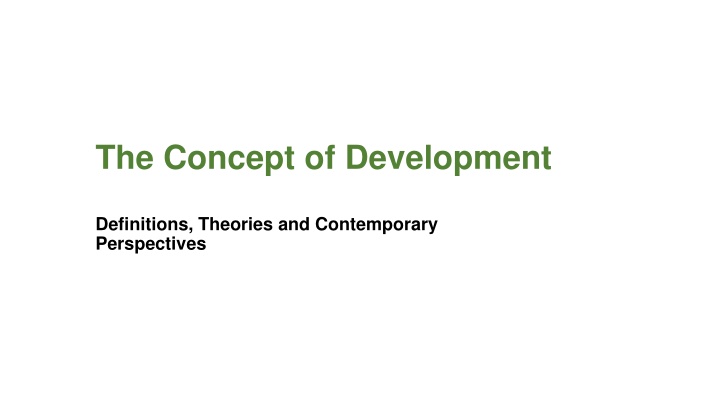
The Concept of Development and Its Various Interpretations
Explore the multifaceted concept of development, from different definitions and perspectives to theories such as Keynesian growth theory. Discover the meaning of development, theories of sustainable development, and alternative interpretations shaping the discourse on economic growth and social progress.
Download Presentation

Please find below an Image/Link to download the presentation.
The content on the website is provided AS IS for your information and personal use only. It may not be sold, licensed, or shared on other websites without obtaining consent from the author. If you encounter any issues during the download, it is possible that the publisher has removed the file from their server.
You are allowed to download the files provided on this website for personal or commercial use, subject to the condition that they are used lawfully. All files are the property of their respective owners.
The content on the website is provided AS IS for your information and personal use only. It may not be sold, licensed, or shared on other websites without obtaining consent from the author.
E N D
Presentation Transcript
The Concept of Development Definitions, Theories and Contemporary Perspectives
Definitions of Development For almost every writer a different definition of development exists. Its Important to first distinguish between- a. Development as a state or condition-static b. Development as a process or course of change-dynamic
Meaning of Development-Todaro Development is process of improving the quality of all human lives with three equally important aspects. These are- 1. Raising peoples living levels, i.e. incomes and consumption, levels of food, medical services, education through relevant growth processes. 2. Creating conditions conducive to the growth of peoples self-esteem through the establishment of social, political and economic systems and institutions which promote human dignity and respect. 3. Increasing peoples freedom to choose by enlarging the range of their choice variables, e.g. varieties of goods and services.
Alternative Interpretations of Development/Characteristics (Mabogunje) Development as Economic Growth- too often commodity output as opposed to people is emphasized-measures of growth in GNP. Development as Modernization- emphasizes process of social change which is required to produce economic advancement examines changes in social, psychological and political processes Development as Distributive Justice- view development as improving basic needs. arget groups include small farmers, landless, urban under-employed and unemployed Emphasizes Mode of Production - elements and activities necessary to produce and reproduce real, material life
Sustainable Development: Defined as development that is likely to achieve lasting satisfaction of human needs and improvement of the quality of life and encompasses Help for the very poorest who are left with no option but to destroy their environment to survive. Idea of self-reliant development with natural resource constraints Cost effective development using different economic criteria to the traditional i.e. development should not degrade environment Important issues of health control, appropriate technologies, food self-reliance, clean water and shelter for all.
Theories of Development 1940-50s- Keynesian growth theory -process of capital formation is determined by savings and investment Domestic savings are chanelled to productive investments such as manufacturing which result usually-in high productivity. Growth is market driven as income levels rise, savings rises and frees capital for alternative investment.
Modernization Theory -as noted previously this theory suggests that economic dimension alone is insufficient and adds theories on institutional and social change Incorporates non-economic elements such as social practices, beliefs, values and customs (McClelland, Achieving Society) Diffusion and speed of change is critical as is removal of various cultural and social barriers. Backward internal structures-rather than external factors-cause underdevelopment
NeoLiberal Development Theory- grew in the 1970s and designed to counteract impact of Keynesianism New emphasis on supply side factors in development- private initiatives and market led growth Move away from demand stimulation (interest rate manipulation), import substitution, state intervention and centralized planning Gradual industrialization with trickle down of benefits to all social classes
Popular Development- what is it? Avoids grand theories and emphasizes solutions viewed in context of development which is part of historical process. Context of development is constantly changing in scale and time. Accommodates geographical and historical diversity. Not extent of state intervention but comparative advantages of public and private sectors and their complementarity. Stresses local diversity, human creativity, process of social change through pragmatism, flexibility and context.
Popular Development and Environment Recognizes high opportunity costs associated with irreversible environmental damage Dealing with environmental problems requires solutions sensitive to local social and ecological conditions Society and nature relations are affected by variations in class, gender and ethnicity
Development, Space and Place - Bottom up approaches (as opposed to top-down) to peoples participation are important in this view How are various social groups and classes affected by rural-urban, core-periphery and other spatial interactions? Growing importance of decentralization of decision-making and authority from center to periphery
Development and Power- How does the power structure affect development? Examine sources of empowerment, inequality and discrimination Need to devise more people centered approaches which stress empowerment and participation Empowerment as participatory development seeks to engender self-help and self-reliance but also effective collective decision-making
What causes underdevelopment? Very easy to focus on characteristics of development For example we know that underdevelopment is usually characterized by low per capita incomes, low literacy and educational attainment, lack of basic services- water and power But how do we EXPLAIN underdevelopment?
Some Common Theories Old view that absence of development caused by certain physical environments, particular cultural traditions and value systems- environmental and cultural determinism. Lack of natural resources certainly impediment to development but not impossible- example of Japan Why has Japan succeeded?
Reasons for Japanese Success Strong cooperation between government and business Able to adapt to spatial-physical situation and acquire a maritime prowess Early development of transport and banking systems Highly literate population Niche development- technology driven
Other Common Explanations of Underdevelopment Instability and other adverse internal situations- political factors Some truth to this as extended periods of turbulence are not conducive to development- central African nations with tribal rivalries and ethnic cleansing Poor physical environment- lack of rainfall, poor soils also may pose barriers to development






















